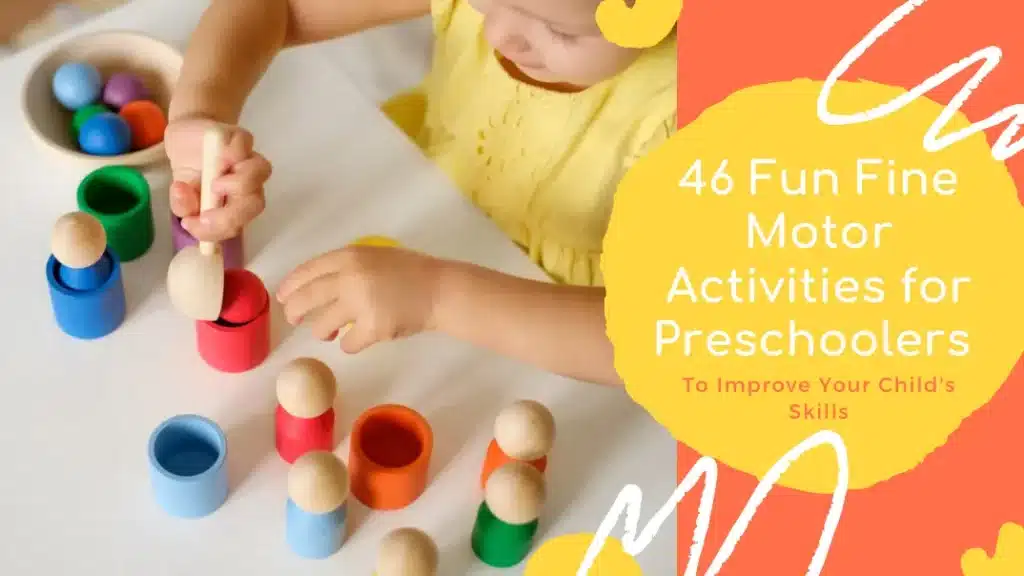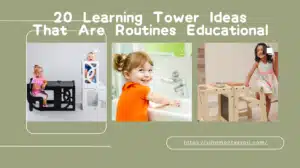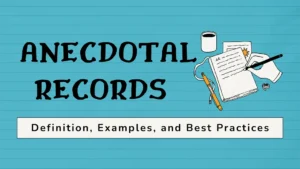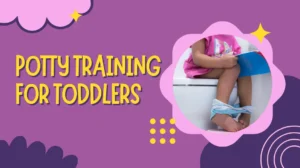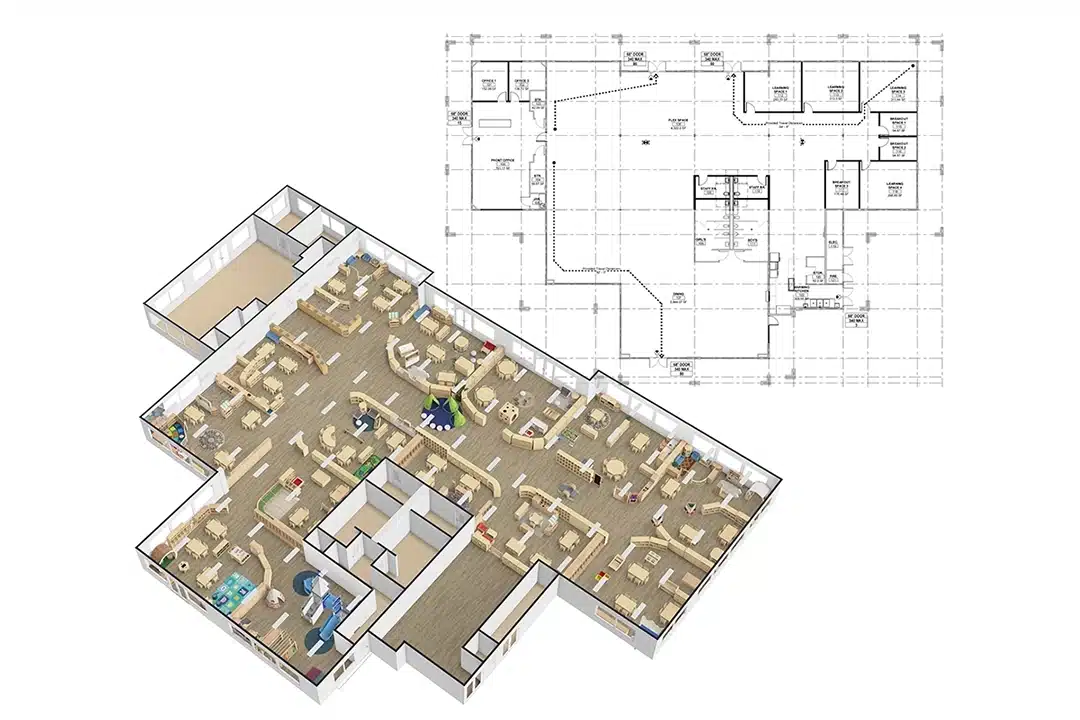Are you looking for fun activities to help preschoolers develop fine motor skills? Do you want to ensure that your child’s hand-eye coordination, dexterity, and overall physical development are on track? Are you finding it difficult to find activities that both engage your child and improve their motor abilities?
Fine motor activities are crucial for preschoolers as they lay the foundation for everyday tasks like writing, drawing, eating, and self-care. Focusing on fine motor skill development can give your child a solid foundation for academic and personal success.
In this article, I’ll share 46 creative and fun fine motor activities for preschoolers that will enhance their skills, spark creativity, and encourage independent learning.
What Are Fine Motor Skills?
Fine motor skills are the small muscle movements children need to develop to complete tasks like holding a pencil, eating with utensils, or even tying shoes. These tasks require fine motor integration of hand-eye coordination and dexterity. Children who engage in fine motor activities refine their ability to control small muscles, which is crucial for their everyday activities.
These skills are foundational to preschoolers’ growth. Fine motor activities are vital for encouraging coordination, dexterity, and precision. As children engage in these exercises, they enhance their ability to perform small, controlled movements and interact with their environment meaningfully.

Importance of Fine Motor Activities for Development
Fine motor activities aren’t just about improving hand strength—they directly impact a child’s overall development. Here’s why they matter:
- Self-Care Independence
As children practice fine motor skills exercises, they can perform self-care tasks, like buttoning clothes or using utensils, which promotes their independence. - Hand-Eye Coordination
Fine motor activities enhance the ability to use both hands and eyes to accomplish tasks, an essential skill for tasks like reading or playing sports. - Strength and Dexterity
Through repetitive tasks, preschoolers can strengthen their hand muscles, improving their ability to grasp, pinch, and manipulate objects. - Academic Readiness
A strong foundation in fine motor skills allows children to excel in writing, coloring, and using scissors. These abilities play an important role in preschool fine motor activities and help children prepare for school. - Cognitive Development
Engaging in tasks like sorting objects or using fine motor toys promotes problem-solving and critical thinking, boosting your child’s cognitive skills. - Improve Dexterity and Precision
Many fine motor activities involve tasks that require delicate and precise movements. As children practice these tasks, they become more adept at using their hands and fingers with increasing accuracy.
How to Choose the Right Fine Motor Activities?
When selecting fine motor activities for preschoolers, it’s important to consider the following factors:
- Age Appropriateness: Ensure that toddlers’ fine motor activities are simpler, such as stacking rings or sorting large beads, while older preschoolers can engage in more advanced tasks like using scissors or writing letters.
- Skill Level: Start with easy-to-complete fine motor practice activities, gradually increasing their difficulty as your child’s skills improve.
- Engagement: Choose fun and engaging activities to keep your child interested and motivated to practice their motor skills.
- Safety: Ensure that any tools or materials used in fine motor activities are safe for your child’s age group.
Fine motor activities for preschoolers
Here are 46 fun and creative fine motor activities for preschoolers to engage your child while developing their essential motor skills. These activities will help enhance fine motor integration, improve dexterity, and build the hand-eye coordination necessary for success in school and life.
1. Peel and Stick Stickers
Peeling and sticking stickers is a simple yet effective activity that helps children develop hand control and finger strength. It also enhances their focus and patience as they peel the stickers carefully. Placing the stickers on paper can encourage creativity and improve spatial awareness as they arrange designs.

Materials Needed:
- Sticker sheets (variety of shapes and sizes)
- Paper or notebook
Setup:
- Give your child a sheet of stickers and a blank piece of paper or notebook.
- Encourage them to peel off the stickers one by one.
- Have them place the stickers on the paper, arranging them into patterns or designs if desired.
2. Make Spaghetti Necklaces
Making spaghetti necklaces is a fun craft activity that helps preschoolers practice hand-eye coordination and precision. Threading pasta onto string requires concentration and strengthens the muscles in their fingers, which are important for more complex tasks like writing or using scissors. It also provides a creative outlet as they design their necklaces.

Materials Needed:
- Uncooked spaghetti (pasta)
- String or yarn
- Food coloring (optional)
Setup:
- Optionally, color the spaghetti by soaking it in food coloring.
- Give your child string or yarn, and guide them to thread the pasta onto the string.
- Encourage them to create patterns or make a necklace or bracelet.
3. Shred or Crumple Paper
Shredding or crumpling paper is a tactile activity that helps strengthen the small muscles in the hands and fingers. Children rip or crumple paper and improve their grip strength and dexterity. This activity can be an enjoyable sensory experience and offers a great way to release energy and practice motor control.
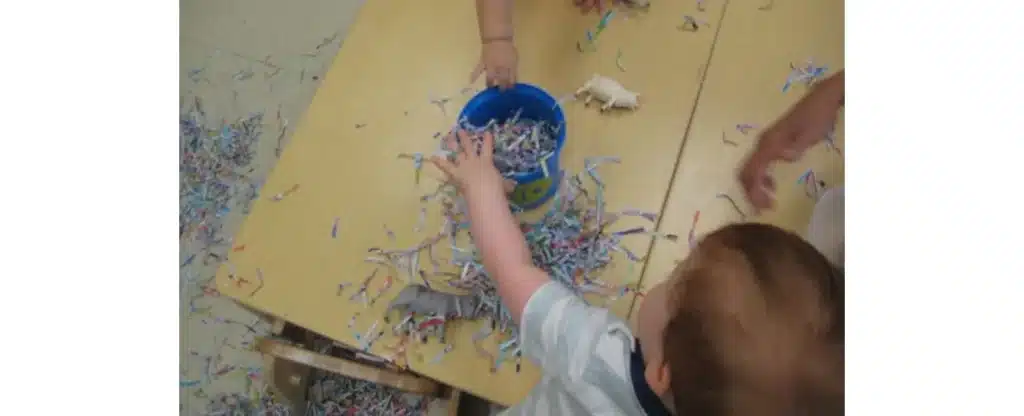
Materials Needed:
- Old newspapers or scrap paper
Setup:
- Give your child some newspaper or scrap paper.
- Encourage them to tear, rip, or crumple the paper into small pieces.
- You can also provide a container where they can place the crumpled paper pieces to enhance the challenge.
4. Put Coins in a Piggy Bank
Inserting coins into a piggy bank is an easy and practical way for children to develop hand coordination and improve their fine motor skills. This activity requires precision as the coins are placed in the slot, and it also introduces basic concepts of sorting and counting. It’s a simple yet effective way to enhance finger control.
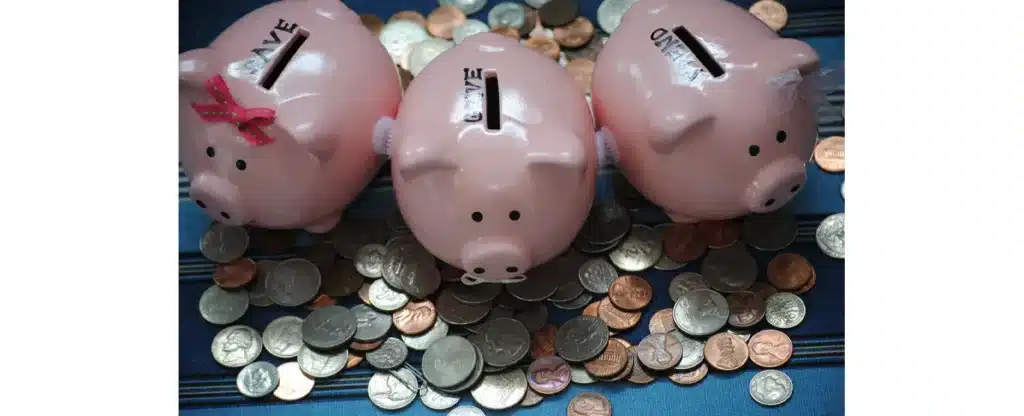
Materials Needed:
- Coins (variety of sizes)
- Piggy bank or small container with a coin slot
Setup:
- Provide a variety of coins (e.g., pennies, dimes, quarters).
- Encourage your child to insert the coins into the piggy bank or container.
- You can make the task more engaging by having your child sort the coins by size or value before placing them in the bank.
5. Attach Clothespins to Board Books
Attaching clothespins to a board book or cardboard is great for building finger strength and improving coordination. Pinching and releasing the clothespin strengthens the pincer grasp, a vital skill for later tasks like writing and holding objects. It also encourages independent play and problem-solving.

Materials Needed:
- Clothespins
- Board books or cardboard pieces
Setup:
- Give your child a few clothespins and a board book or piece of cardboard.
- Encourage them to attach the clothespins to the edges of the book or cardboard.
- This simple activity strengthens their fingers while also encouraging independent play.
6. Classic Sidewalk Chalk
Sidewalk chalk is a fantastic way for preschoolers to practice fine motor skills outdoors. Drawing shapes, letters, or simple pictures on the pavement requires hand control and coordination. It’s also a great way to encourage creativity while building essential motor skills. The large sweeping movements also help children refine their grip.

Materials Needed:
- Sidewalk chalk
Setup:
- Take your child outside and provide them with some sidewalk chalk.
- Encourage them to draw shapes, patterns, or pictures on the sidewalk or driveway.
- You can give them specific challenges, such as drawing certain shapes or letters, to improve their creativity and fine motor control.
7. Thread and Tie
Threading and tying knots are important skills for fine motor development. These tasks require precision and careful finger control, essential for everyday activities such as tying shoelaces or buttoning a shirt. This activity can also help your child develop patience and persistence as they master the steps.

Materials Needed:
- String or yarn
- Items to tie (e.g., shoes, cloth strips)
Setup:
- Provide a piece of string or yarn.
- Guide your child through threading and tying simple knots using the yarn.
- You can introduce more complex knots as your child’s skills progress, such as tying shoes or attaching objects with knots.
8. Play with Playdough and Putty
Playdough and putty are versatile tools for fine motor practice. Molding, rolling, and shaping these materials requires finger strength and dexterity. Children can manipulate the dough into shapes, figures, and designs, which helps improve their grasp and encourages creativity. It’s also a great stress-relieving activity for young children.

Materials Needed:
- Playdough or putty
Setup:
- Provide your child with a lump of playdough or putty.
- Encourage them to roll, squeeze, shape, and mold the dough into different shapes or figures.
- For more complex creations, offer tools like small plastic cutters, rolling pins, or molds.
9. Pick Up Sticks
Picking up sticks or other small objects helps develop the pincer grasp and improves hand-eye coordination. This simple activity requires children to focus on their movements while strengthening their hand muscles. It can also become a fun challenge by timing how quickly your child can collect the sticks or make it a sporting activity.

Materials Needed:
- Small sticks or pebbles
- Small container
Setup:
- Scatter small sticks or pebbles on a flat surface.
- Encourage your child to pick them up individually using their fingers or tweezers.
- You can make this more engaging by providing a container for your child to place the picked-up objects in or challenging them to pick them up in a specific order.
10. Pop Bubbles
Popping bubbles may seem simple, but it’s an effective and fun way for children to practice hand-eye coordination. As your child reaches out to pop the bubbles, they engage their hand muscles and improve motor control. It’s a playful outdoor activity that gets children moving while enhancing their fine motor skills.
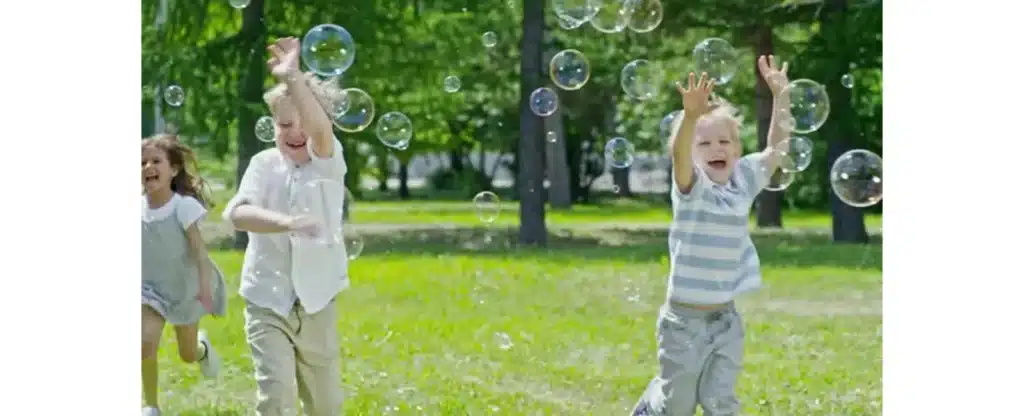
Materials Needed:
- Bubble solution
- Bubble wand
Setup:
- Blow bubbles using the wand and encourage your child to pop them.
- Having your child aim for smaller or pop bubbles in a specific area can make it more challenging.
- For added fun, you can encourage them to chase the bubbles around, increasing physical movement and motor skill development.
11. Sorting Coins or Beads
Sorting coins or beads by color, size, or type is an excellent activity for building fine motor skills. It helps children develop hand strength and finger dexterity while manipulating small objects. Sorting also encourages attention to detail and categorization, which are important cognitive skills.

Materials Needed:
- Coins or beads of different colors and sizes
- Small containers or bowls for sorting
Setup:
- Provide your child with a variety of coins or beads.
- Ask them to sort the objects into containers based on color, size, or type.
- You can make the activity more challenging by increasing the variety of objects or by setting a timer to see how fast they can sort.
12. Putting Pegs into Pegboards
Using a pegboard and pegs is a simple way to strengthen finger muscles and improve hand-eye coordination. This activity requires children to insert pegs into the holes on the board, which helps improve their precision and fine motor control. It also promotes problem-solving as they figure out how to fit pegs in the correct spaces.

Materials Needed:
- Pegboard
- Pegs (in different colors, if possible)
Setup:
- Give your child a pegboard and a set of pegs.
- Encourage them to randomly insert the pegs into the holes or follow patterns.
- You can ask your child to create specific shapes or designs with the pegs for an added challenge.
13. Playing with Puzzles
Puzzles are a fantastic way to engage children in fine motor play while helping with cognitive development. Manipulating puzzle pieces to fit into the correct spaces builds problem-solving and hand-eye coordination. It enhances spatial awareness and encourages patience as children work through the puzzle.
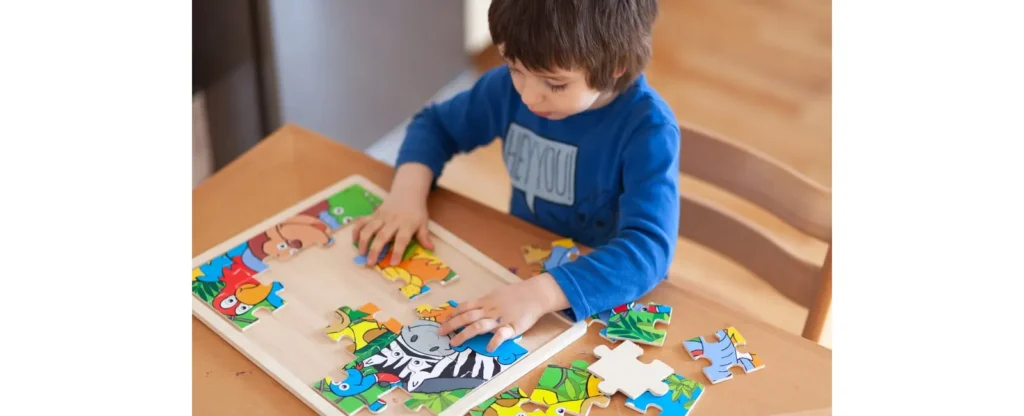
Materials Needed:
- Puzzles (with large, simple pieces for preschoolers)
Setup:
- Provide your child with an age-appropriate puzzle, ensuring the pieces are large enough for them to handle.
- Encourage them to work through the puzzle independently or with minimal guidance.
- Celebrate their accomplishment as they complete the puzzle and ask them to explain the picture or shapes they created.
14. Using Syringes and Eyedroppers for Art Projects
Using syringes or eyedroppers filled with watercolors or colored liquid is a unique and engaging way to help children develop their fine motor skills. This activity requires them to use their fingers to squeeze and control the liquid, helping improve grip strength and precision. It also encourages creativity in the form of art.
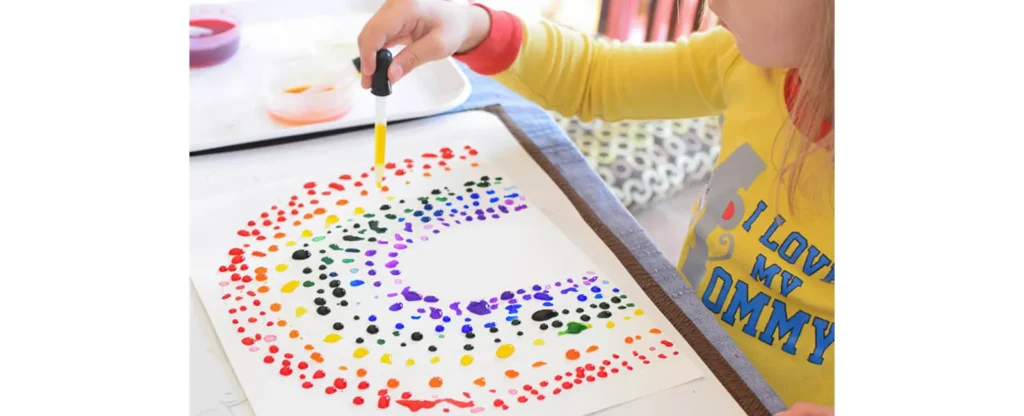
Materials Needed:
- Syringes or eyedroppers
- Watercolor paints or colored liquid
- Paper
Setup:
- Provide your child with a syringe or eyedropper filled with watercolor or colored liquid.
- Let them squeeze the liquid onto paper, creating designs, patterns, or pictures.
- Encourage them to experiment with different techniques, such as making spots or lines, to practice control over the amount of liquid used.
15. Engage in Origami
Origami, the Japanese art of paper folding, is a wonderful activity for developing fine motor skills, concentration, and patience. The delicate nature of folding paper into various shapes requires precision and attention to detail, making it an excellent exercise for young hands. It also allows for creativity in designing different shapes and animals.

Materials Needed:
- Square pieces of paper
- Instructions for basic origami figures (or you can guide them yourself)
Setup:
- Provide your child with a square piece of paper and origami instructions.
- Start with simple shapes, like a paper boat or crane, and guide your child through folding.
- As your child becomes more comfortable with the folds, encourage them to try more complex designs and practice following step-by-step instructions.
16. Fruit Loops and Spaghetti Strings
This activity combines color recognition and fine motor skill development. Threading colorful Fruit Loops onto a spaghetti or yarn enhances hand-eye coordination and dexterity. It also helps improve the pincer grasp, which is important for tasks like picking up small objects or holding a pencil.
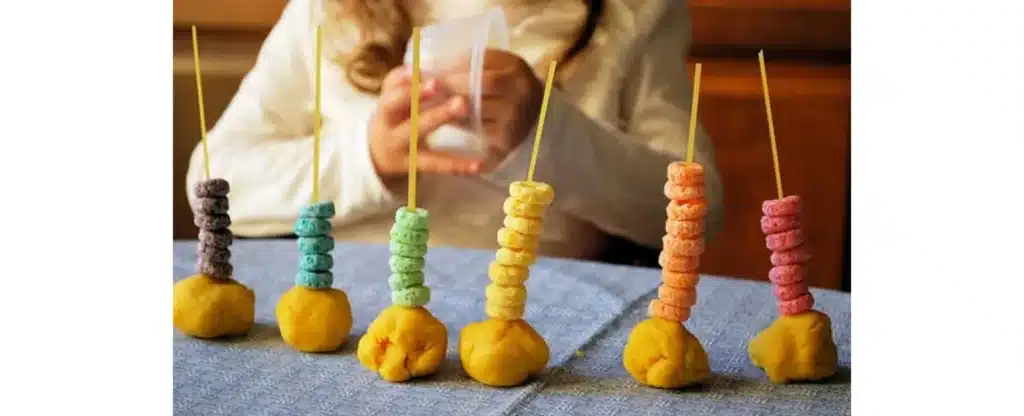
Materials Needed:
- Fruit Loops cereal
- Yarn or uncooked spaghetti
- Scissors (optional, if you want to cut the spaghetti into smaller pieces)
Setup:
- Provide your child with a piece of yarn or uncooked spaghetti.
- Encourage them to thread the Fruit Loops onto the yarn, creating a necklace or bracelet.
- Challenge them to create patterns using different colors of Fruit Loops to increase the complexity of the task.
17. Craft Art Sculptures
Crafting sculptures using various materials, such as pipe cleaners, cotton balls, or clay, helps children develop their fine motor skills while fostering creativity. This activity involves manipulating different textures and materials and strengthening hand and finger muscles while allowing children to create unique, tactile art projects.

Materials Needed:
- Pipe cleaners
- Cotton balls
- Clay or modeling dough
- Glue (optional)
Setup:
- Provide your child with various crafting materials like pipe cleaners, cotton balls, or clay.
- Encourage them to create sculptures by bending, twisting, and shaping the materials into different forms (e.g., animals, flowers, or abstract shapes).
- Allow them to glue parts together for added stability and creativity.
18. Counting with Rubber Bands
Counting with rubber bands offers an excellent opportunity to practice fine motor control while reinforcing early math skills. Stretching the rubber bands around objects or counting how many rubber bands fit around a specific item helps preschoolers strengthen their hand muscles and improve precision.

Materials Needed:
- Rubber bands
- Small objects to wrap the rubber bands around (e.g., pencils, markers, or cups)
Setup:
- Give your child a set of rubber bands and small objects to wrap them around.
- Encourage them to count how many rubber bands they can place on each object.
- As a challenge, you can also have them stretch the rubber bands around the objects without touching the sides, increasing the task’s difficulty.
19. Pom Poms in Water Bottles
Placing pom-poms into a water bottle is a fun and effective way for children to practice fine motor skills while working on problem-solving and spatial awareness. This activity requires them to manipulate small objects and fit them into a confined space, strengthening their hand muscles and improving concentration.

Materials Needed:
- Pom-poms (variety of sizes)
- Clear plastic water bottles or containers
Setup:
- Provide your child with a water bottle or any clear container with a small opening.
- Encourage them to drop or fit the pom-poms into the bottle individually.
- You can also ask them to sort the pom-poms by color or size before placing them in the bottle to add an extra challenge.
20. Cardboard Roll and Straw Threading
Threading straws through holes in a cardboard roll is a simple yet effective fine-motor activity. It helps children practice hand-eye coordination and precision while working on their pincer grip. It’s also a great way to repurpose household materials into a fun and educational activity.

Materials Needed:
- Cardboard roll (from toilet paper or paper towels)
- Straws (cut into shorter pieces if necessary)
Setup:
- Provide your child with a cardboard roll and a set of straws.
- Punch small holes along the length of the cardboard roll (or you can use a hole puncher to make it easier for smaller children).
- Encourage your child to thread the straws through the holes in the cardboard roll, creating patterns or practicing their threading skills.
21. Sticker Color Sorting
Sticker color sorting is a simple yet effective way to improve hand-eye coordination and finger dexterity while helping preschoolers learn about colors and categorization. Using stickers, children practice their ability to peel and place stickers, enhancing their fine motor skills in a fun, creative way.
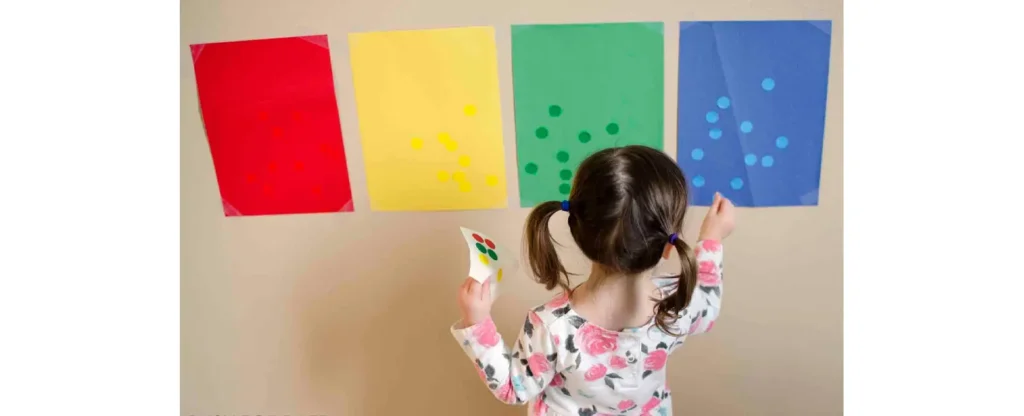
Materials Needed:
- Stickers in various colors
- Paper or small containers for sorting
Setup:
- Provide your child with a set of colorful stickers.
- Encourage them to peel off the stickers and sort them by color onto different areas of a piece of paper or into small containers.
- You can add a challenge by asking your child to create patterns with the stickers or arranging them in specific color sequences.
22. Q-Tip and Straw Activity
Using Q-tips and straws to create patterns or designs is a fun and tactile way for children to practice their fine motor skills. The small size of the Q-tips and straws requires careful handling, which helps improve finger strength and hand control. It’s also a great opportunity to work on creativity and focus.

Materials Needed:
- Q-tips
- Straws (cut into small pieces if necessary)
- Paper and glue (optional)
Setup:
- Provide your child with Q-tips and small pieces of straws.
- Encourage them to arrange the Q-tips and straw pieces into patterns, shapes, or designs on paper.
- Once they’re done, they can glue the pieces onto the paper or simply use them as manipulatives to learn colors or shapes.
23. Stacking Erasers
Stacking erasers is a simple yet effective activity for developing fine motor skills. The small, lightweight erasers require precision and careful hand movements to stack neatly. This activity helps strengthen finger muscles and hand-eye coordination and provides a great opportunity for children to practice patience and focus.

Materials Needed:
- Small erasers (preferably ones with a flat, wide surface for stacking)
Setup:
- Provide your child with a set of small, flat erasers.
- Encourage them to stack the erasers one on the other, creating a tower.
- Challenge them to see how high they can stack the erasers without the tower falling over, helping them practice their stability and concentration.
24. Toothpick Sculptures
Building toothpick sculptures is a great way for preschoolers to practice fine motor skills while working on creativity and problem-solving. Inserting toothpicks into soft materials, such as playdough or clay, helps develop finger control and precision. It’s also a fantastic way to encourage spatial thinking and imaginative design.

Materials Needed:
- Toothpicks
- Playdough or clay
Setup:
- Give your child a handful of toothpicks and a lump of playdough or clay.
- Encourage them to insert the toothpicks into the playdough or clay to create structures or sculptures.
- To challenge their fine motor skills and creativity, they can try making shapes like cubes, pyramids, or even abstract designs.
25. Pulling Cotton Balls Apart
Pulling cotton balls apart is a simple and enjoyable activity that helps develop hand strength and fine motor control. The soft texture of the cotton balls makes the task both fun and soothing. This activity strengthens the fingers and enhances their ability to grasp and manipulate objects, which is essential for later tasks like writing.

Materials Needed:
- Cotton balls
Setup:
- Provide your child with a few cotton balls.
- Encourage them to pull the cotton balls apart, either using their hands or tweezers for an added challenge.
- You can ask them to pull the cotton into different sizes or shapes, adding creativity to the activity.
26. Stacking Cups
Stacking cups is a classic activity that helps preschoolers develop hand-eye coordination and precision. The action of stacking cups requires children to use both hands together and practice balance and stability. As they work to create tall towers, they enhance their grip strength and concentration, all while engaging in a fun and rewarding challenge.

Materials Needed:
- Plastic or paper cups
Setup:
- Provide your child with a set of plastic or paper cups.
- Encourage them to stack the cups one on top of the other, creating towers of varying heights.
- Challenge them to create the tallest tower or to stack the cups in a specific pattern or order.
27. Dexterous Pliers Grasping Activity
Using pliers to grasp and manipulate objects is an excellent way to improve finger strength, precision, and coordination. This activity is particularly helpful for strengthening the pincer grasp, which is crucial for tasks like holding a pencil or eating with utensils. It also allows children to practice fine motor control and patience.

Materials Needed:
- Small pliers or tongs
- Small objects (e.g., pom-poms, beads, or buttons)
Setup:
- Provide your child with pliers, tongs, and small objects like pom-poms or buttons.
- Encourage them to use the pliers to pick up and transfer the objects into a separate container.
- You can increase the difficulty by using smaller objects or setting a timer to challenge them to pick up the most items in a specific time.
28. Homemade Pegboard Activity
Creating and using a homemade pegboard is a fantastic way to practice fine motor skills, particularly for improving hand strength and coordination. Inserting pegs into small holes helps children improve their dexterity while encouraging them to follow patterns and instructions. It’s a fun, hands-on way to engage their minds and hands.

Materials Needed:
- Cardboard or wooden board
- Pegs (can be small dowels or wooden sticks)
- Hole punch or drill (to create holes)
Setup:
- Create a simple pegboard by cutting small holes in a cardboard or wooden board.
- Provide your child with pegs or dowels that fit into the holes.
- Encourage them to randomly insert the pegs into the holes or follow patterns. You can challenge them to create a specific design or pattern.
29. Fishing with Magnets
Fishing with magnets is an interactive and engaging activity that helps preschoolers develop hand-eye coordination and fine motor control. Children practice precision and concentration by using a magnetic fishing rod to catch objects. This activity can be adapted to suit different skill levels and can be a fun, dynamic experience for children.

Materials Needed:
- Magnetic fishing rod (or a string with a magnet tied to it)
- Small metal objects (e.g., paper clips, metal washers)
- Small container or bucket
Setup:
- Set up a “fishing area” by scattering small metal objects like paper clips or washers on the floor or in a container.
- Provide your child with a magnetic fishing rod or string with a magnet at the end.
- Encourage them to “fish” for the metal objects by guiding the magnet to attract and pick them up.
- You can add a fun challenge by timing how long it takes to catch all the objects.
30. Rubber Band Jars
The rubber band jar activity is a simple and effective way to improve finger strength and coordination. Stretching and placing rubber bands around objects helps children develop the muscles for more intricate hand movements. This activity is great for enhancing grip strength and practicing dexterity in a fun, hands-on way.

Materials Needed:
- Rubber bands
- Small jars or containers (various sizes)
Setup:
- Provide your child with rubber bands and a few small jars or containers.
- Encourage them to stretch the rubber bands around the containers, focusing on maintaining control and precision.
- For a challenge, you can ask your child to wrap rubber bands around objects of different sizes or time how quickly they can complete the task.
31. Woven Cardboard
Woven cardboard is a fantastic activity for improving hand-eye coordination and dexterity. By weaving string, yarn, or ribbon through slits in a piece of cardboard, children develop their pincer grasp, finger strength, and concentration. It also introduces a basic form of weaving, which can be expanded into more complex crafts as their skills grow.
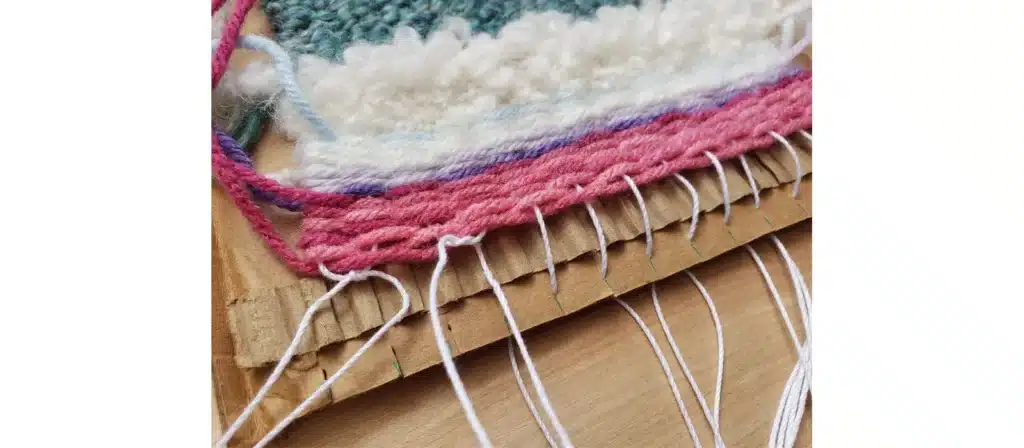
Materials Needed:
- Cardboard (cut into a square or rectangular shape)
- Yarn, string, or ribbon
- Scissors (for cutting the yarn)
Setup:
- Cut slits along the edges of a piece of cardboard.
- Provide your child with yarn, string, or ribbon, and show them how to weave it in and out of the slits.
- Encourage them to create patterns with the yarn or string as they weave, which will improve their fine motor skills and creativity.
32. Building with Legos
Building with Legos is a fun and creative way to strengthen fine motor skills. Snapping small pieces together helps children develop precision, hand strength, and spatial awareness. This activity also fosters creativity as children use the pieces to design structures, vehicles, and more.
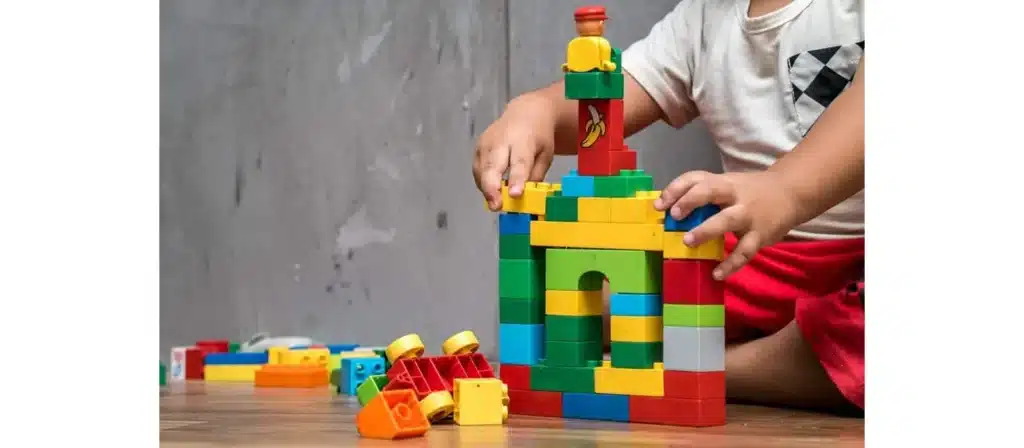
Materials Needed:
- Legos (variety of shapes and sizes)
Setup:
- Provide your child with a collection of Legos.
- Encourage them to build structures, vehicles, or animals, focusing on the precision needed to connect the pieces.
- Challenge them to follow specific patterns or build something of their own design to enhance problem-solving skills.
33. Tracing and Punch Cards
Tracing and punching holes along a card or piece of paper helps improve hand-eye coordination and precision. This activity enhances finger control and strengthens the pincer grasp, which is essential for writing and other tasks requiring dexterity. It also introduces the concept of following a path or shape.

Materials Needed:
- Pre-made punch cards or paper
- A pencil or crayon for tracing
- A hole puncher
Setup:
- Provide your child with a punch card or a piece of paper with shapes or designs to trace.
- Encourage them to trace along the lines with a pencil or crayon, focusing on precision.
- After tracing, they can use a hole puncher to create holes along the traced lines, which adds a new level of fine motor practice.
34. Squirt Bottles
Using squirt bottles helps children develop finger strength, dexterity, and hand-eye coordination. Squeezing the bottle to spray water or paint requires precise control and engages the small muscles in the hands and fingers. This activity is especially fun outdoors and can be easily adapted for different ages.

Materials Needed:
- Squirt bottle (plastic, child-safe)
- Water, food coloring, or paint (optional)
Setup:
- Fill a squirt bottle with water, food coloring, or paint.
- Provide your child with a surface to squirt the liquid onto (e.g., a sidewalk, piece of paper, or outdoor surface).
- Encourage them to practice spraying in different directions or creating shapes and designs by controlling the squirt.
35. Tennis Monsters
The tennis monster activity is a playful and active way to help children develop hand-eye coordination and motor control. This fun game involves using a tennis ball and various hand movements to catch, toss, and control the ball, strengthening both large and fine motor skills. It’s a dynamic way to practice hand-eye coordination while engaging in physical play.

Materials Needed:
- Tennis ball (or any soft, bouncy ball)
- Large container or basket
Setup:
- Give your child a tennis ball and show them how to throw and catch it.
- You can set up a basket or container for younger children and encourage them to toss the ball into the basket.
- Increase the difficulty by having your child perform tasks like bouncing the ball on the floor and then catching it or tossing it to a specific target.
36. Pom Pom Sorting
Sorting pom-poms by size, color, or texture is an excellent way to develop fine motor skills and enhance color recognition. The task requires children to pick up and move small objects, which helps improve their grasp and finger strength. Additionally, it encourages focus and organizational skills as they categorize the pom-poms.

Materials Needed:
- Pom-poms (variety of colors and sizes)
- Small containers or bowls for sorting
Setup:
- Provide your child with a set of pom-poms in different colors and sizes.
- Ask them to sort the pom-poms into containers based on their attributes (color, size, texture).
- You can increase the complexity by setting a timer or challenging your child to sort the pom-poms in a specific order.
37. Grasping and Shaking Rattles
Grasping and shaking rattles is a simple yet effective activity for developing hand strength and coordination in young children. The shaking motion helps them practice control over their movements, while the grip required to hold the rattle builds finger strength and dexterity. It’s also an enjoyable way to engage the senses with sound and movement.

Materials Needed:
- Rattles (variety of sizes, if possible)
Setup:
- Provide your child with a rattle.
- Encourage them to grasp the rattle tightly and shake it to produce sound.
- You can add variety by providing different types of rattles and having your child switch between them, allowing them to practice using different grip styles.
38. Squeeze Toys
Squeeze toys are great for strengthening hand muscles and improving dexterity. When children squeeze the toy, they engage their hand and finger muscles, which is vital for developing the control needed for tasks such as writing. It’s a fun and sensory-rich activity that can help children relax while building fine motor strength.

Materials Needed:
- Squeeze toys (such as stress balls, squishy animals, or textured toys)
Setup:
- Provide your child with a variety of squeeze toys.
- Encourage them to squeeze the toys repeatedly, focusing on using their fingers and palms.
- To increase difficulty, challenge your child to squeeze the toy while holding it in different positions, such as with one hand or only using their fingertips.
39. Stirring and Mixing
Stirring and mixing materials, whether in a bowl or with playdough, is an excellent activity for improving fine motor skills. The repetitive motion helps strengthen hand muscles and wrist control while improving coordination. Plus, it’s a fun, multi-sensory experience that can be incorporated into cooking or crafting activities.

Materials Needed:
- Bowls or containers
- Stirring tools (e.g., spoons, whisks, or small spatulas)
- Ingredients to mix (e.g., playdough, water, or baking ingredients)
Setup:
- Provide your child with a bowl, spoon, or whisk.
- Offer materials to mix, such as ingredients for a simple recipe or playdough.
- Encourage your child to stir the materials, using controlled motions to practice wrist and finger movements.
40. Tie Cards
Tie cards help preschoolers practice tying knots and laces, which is essential for self-care skills like tying shoes. This activity improves finger strength, dexterity, and coordination. As children work to complete the task correctly, it also teaches patience and persistence. It’s a practical skill-building activity that prepares them for everyday life.
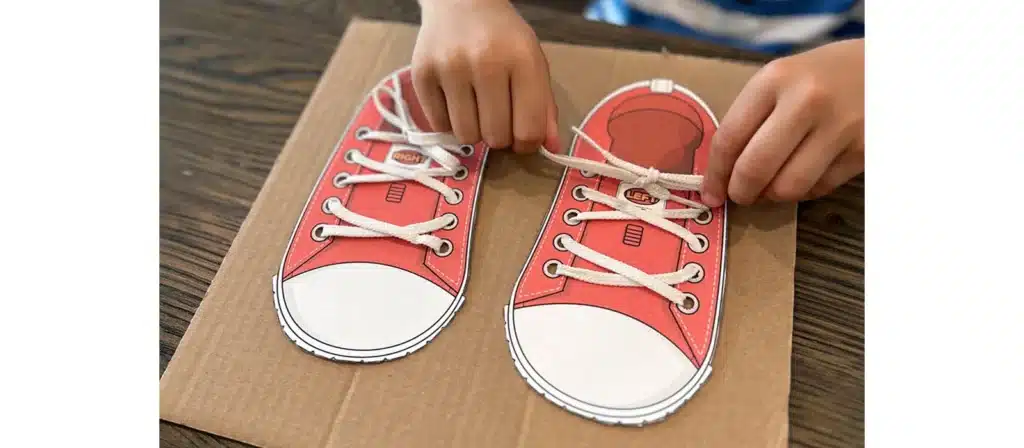
Materials Needed:
- Tie cards (cards with attached strings or shoelaces for practice)
- Laces or ribbons
Setup:
- Give your child a tie card or piece of fabric with strings attached.
- Show them how to tie knots or practice tying shoelaces using the strings.
- Encourage them to practice independently, offer assistance only when needed, and gradually increase the difficulty using more complex knots.
41. Finger Painting
Finger painting is an enjoyable and creative way for preschoolers to improve fine motor skills. Using their fingers to spread paint encourages hand-eye coordination, strengthens finger muscles, and allows them to express themselves artistically. This tactile activity engages multiple senses while also boosting creativity and focus.
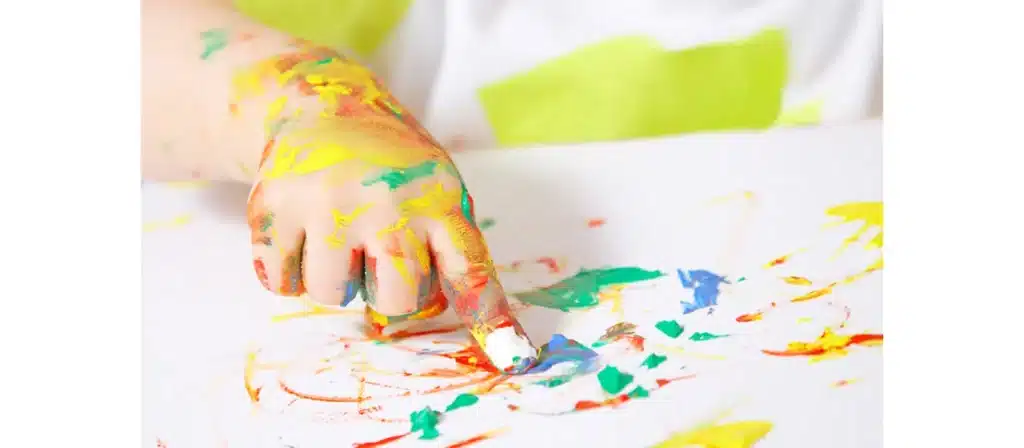
Materials Needed:
- Non-toxic finger paint
- Large sheets of paper
- Old clothes or aprons to protect clothing
Setup:
- Provide your child with a tray or large sheets of paper to work on.
- Pour different colors of non-toxic finger paint onto the paper or tray.
- Encourage your child to use their fingers to spread and mix the colors, creating abstract designs or pictures. Let them explore patterns, shapes, and textures as they play.
42. Gardening
Gardening allows preschoolers to practice fine motor skills while connecting with nature. Digging, planting, and watering require small hand muscles, helping children develop dexterity and strength. Gardening also encourages patience and teaches responsibility as they care for the plants they grow.

Materials Needed:
- Small garden tools (e.g., child-sized shovel, rake)
- Soil
- Seeds or small plants
- Watering can
Setup:
- Provide your child with small gardening tools and a patch of soil or planting pot.
- Guide them as they dig small holes for the seeds, plant them, and gently water them.
- Encourage your child to care for the plants, water them regularly and watch them grow over time.
43. Button Sorting
Sorting buttons by size, color, or shape is a fantastic way to develop fine motor skills in preschoolers. Handling buttons requires children to use their pincer grasp and helps improve finger strength and dexterity. Additionally, sorting activities encourage cognitive development by fostering categorization and organization skills.

Materials Needed:
- Buttons in various sizes, colors, and shapes
- Small containers or bowls for sorting
Setup:
- Provide your child with a selection of buttons in different sizes, shapes, and colors.
- Encourage them to sort the buttons into separate containers based on their attributes.
- You can increase the complexity by asking your child to create patterns or sequences with the buttons.
44. Button and Zipper Practice
Buttoning and zipping are essential life skills that also support fine motor development. Practicing with large buttons and zippers helps children improve their hand strength and coordination, essential for dressing and other everyday tasks. This activity encourages independence and builds confidence as children gain the ability to complete these tasks on their own.

Materials Needed:
- A button board or shirt with buttons
- A zipper practice board or jacket
Setup:
- Give your child a button board or an old shirt with buttons to practice fastening and unfastening.
- Offer a zipper practice board or a jacket with a zipper for them to practice zipping and unzipping.
- Guide them through the motions first, then encourage them to practice independently.
45. Easter Egg Painting
Painting Easter eggs is a fun festive activity that helps children improve fine motor skills while celebrating holidays. The intricate movements required for painting eggs help strengthen finger control and coordination. It also allows children to practice patience and attention to detail while working on small, delicate surfaces.

Materials Needed:
- Plastic or real eggs (if using real eggs, ensure they are hard-boiled)
- Non-toxic paint
- Brushes or sponges
Setup:
- Provide your child with plastic or hard-boiled eggs and non-toxic paint.
- Give them brushes or sponges to apply the paint to the eggs, and encourage them to use their creativity to decorate them.
- You can introduce patterns, color mixing, or even designs for added complexity.
46. Paper Clips
Manipulating paper clips is a simple yet effective activity for improving finger strength and dexterity. Children can practice opening and closing paper clips, which requires them to use small muscles in their fingers and hands. This activity is a great exercise for fine motor development and a useful real-life skill.

Materials Needed:
- Paper clips (variety of sizes)
- Small objects to attach with the paper clips (e.g., paper, cards, or small folders)
Setup:
- Provide your child with a selection of paper clips.
- Encourage them to use the paper clips to attach pieces of paper or small objects.
- Challenge them to use paper clips of different sizes and practice opening and closing them using only their fingers.
Tips for Parents to Support Fine Motor Development
Supporting your child’s fine motor development doesn’t have to be complicated or time-consuming. There are simple and fun activities you can do at home that naturally promote these skills. Here are a few tips to help you get started:
1. Encourage Hands-On Play
Engage your child in building blocks, drawing, or playing with playdough. These activities allow your child to practice using their hands and fingers to manipulate small objects, strengthening fine motor muscles.
2. Use Household Items
You don’t need fancy toys to support fine motor skills. Everyday items such as buttons, straws, or even cotton balls can be used to develop coordination and dexterity. Sorting objects by color, size, or shape is a great way to build fine motor control.
3. Practice Daily Tasks
Incorporate fine motor skills into daily routines. Tasks like buttoning shirts, tying shoes, or using a fork and spoon can be fun ways to build hand strength and coordination. Encourage your child to do these tasks independently, offering guidance when needed.
4. Set Up an Arts and Crafts Station
Art projects such as painting, drawing, and cutting paper are fantastic for improving hand-eye coordination and precision. These activities engage children in using their hands for detailed work, strengthening their fine motor control over time.
5. Be Patient and Provide Encouragement
Fine motor skills take time to develop, so it’s important to be patient with your child as they practice. Provide positive reinforcement when they accomplish tasks, and let them know you’re proud of their efforts.
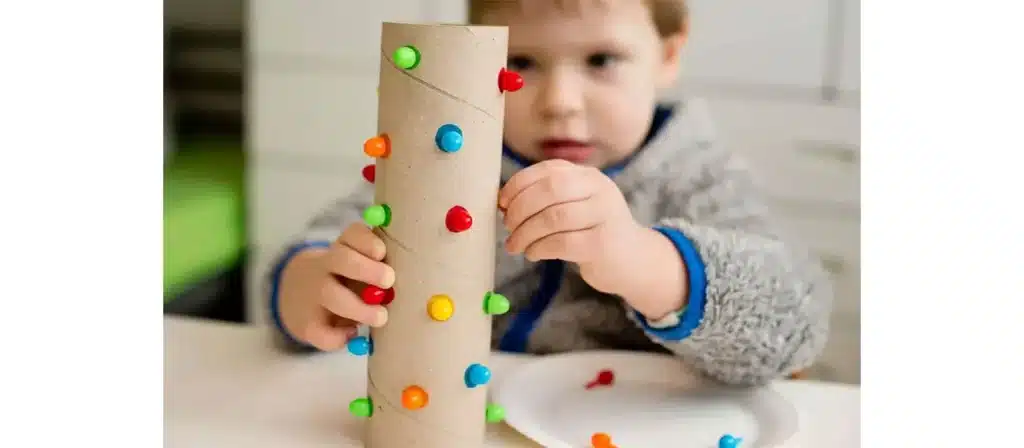
Fine Motor Activities for Autism
For children with autism, fine motor skills development can often be challenging, but progress is possible with the right activities. Children with autism may struggle with sensory processing, coordination, or focus, but engaging them in specific activities tailored to their needs can help improve their fine motor abilities.
- Sensory Play: For children on the autism spectrum, sensory activities are essential. Engaging in tactile play with materials such as sand, playdough, or rice helps children feel more comfortable using their hands and can increase their ability to focus on tasks.
- Puzzle Solving: Puzzles are an excellent activity for children with autism to practice their fine motor skills. Solving puzzles involves hand-eye coordination, spatial awareness, and problem-solving while engaging them in a low-pressure, enjoyable activity.
- Fidget Toys: Fidget toys are particularly helpful for children on the spectrum, as they provide a way to focus and calm themselves. These toys can also encourage hand movements that strengthen fine motor skills.
- Visual and Tactile Activities: For children who benefit from visual and tactile stimulation, activities like stringing beads, lacing cards, or even tearing paper can be great ways to practice fine motor skills while engaging the senses. The key is to ensure the activity is both stimulating and calming.
- Simple Daily Tasks: Incorporating fine motor tasks into every day routines is an excellent way for children with autism to develop independence. Simple activities like using utensils, brushing their teeth, or putting on socks are helpful for fine motor development and boosting self-confidence.
These tailored activities, when paired with consistent practice and a supportive environment, can significantly help children with autism improve their fine motor skills and build their independence.
How to Improve Fine Motor Skills?
Improving fine motor skills is an ongoing process that requires practice, patience, and fun activities. Whether your child is just beginning to develop these skills or needs extra support, there are plenty of ways to help them improve their dexterity and hand-eye coordination.
1. Incorporate Fine Motor Tasks into Play
Children learn best through play, so include fine motor tasks in their playtime. Use toys like puzzles, building blocks, or playdough to help them practice gripping, squeezing, and manipulating objects.
2. Break Tasks into Smaller Steps
When working on tasks that require fine motor skills, break them down into smaller, manageable steps. For example, practice making loops with the laces before attempting to tie the full knot when learning to tie shoes.
3. Use Assistive Tools
Sometimes, children need extra tools or modifications to help them develop fine motor skills. Tools like adaptive scissors grips for pencils, or even larger-sized buttons can help children practice without frustration.
4. Make Activities Fun and Interactive
Incorporate games, music, or rewards to keep fine motor activities fun. You can turn cutting paper, drawing, or putting together a puzzle into a game by timing activities or creating a reward system for your efforts.
5. Encourage Consistency and Repetition
Consistency is key when developing fine motor skills. Set aside time each day for activities like drawing, coloring, or cutting with scissors. Repeating these tasks helps children strengthen the small muscles in their hands and fingers over time.
FAQs
- How can I help my child develop fine motor skills?
You can help develop fine motor skills by providing activities such as drawing, threading beads, cutting, or playing with playdough that require hand-eye coordination and finger manipulation. - What are the best fine motor activities for autism?
Sensory bins, playdough activities, buttoning/zipping practice, bead threading, and puzzle play are all excellent activities for children with autism that help improve fine motor skills. - What age do fine motor skills develop?
Fine motor skills begin to develop in infancy and continue to improve throughout the preschool years, with significant milestones reached between 2-5 years of age. - Can technology be helpful in developing fine motor skills?
Yes, interactive apps and games that encourage drawing, tracing, or building can support fine motor development, but they should be used in moderation alongside hands-on activities. - What are some other Montessori fine motor activities?
Montessori activities like pouring, lacing beads, and using tongs for sorting are excellent for promoting fine motor skills in a hands-on and interactive way. - How can fine motor difficulties be addressed?
If your child struggles with fine motor tasks, consider seeking guidance from an occupational therapist for targeted fine motor interventions. - Are there signs that my child is having difficulty with fine motor skills?
Struggling with tasks like tying shoes, holding a pencil, or buttoning clothes could be a sign that your child needs additional support. - What is the best fine motor activity for 3-year-olds?
Simple activities like playdough sculpting, stringing beads, or coloring with crayons are ideal for 3-year-olds to develop fine motor skills. - How often should I practice fine motor activities with my child?
Aim for at least 15-30 minutes of fine motor activities each day, depending on your child’s age and attention span.
Conclusion
Fine motor activities are essential for preschoolers as they lay the foundation for many everyday tasks. By engaging in fun, creative activities at home and outside, you can help your child develop critical skills in a way that feels exciting and natural. Don’t forget to keep it fun, as the best way to foster development is through enjoyable and meaningful play!

